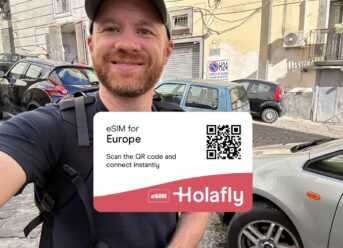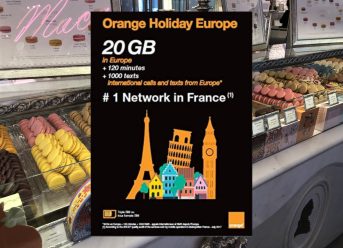
Switzerland is one of the most expensive countries in the world so don’t make it even more expensive by overpaying for mobile data. In this guide to mobile data in Switzerland, I’ll show you how to buy a SIM Card for Switzerland and point out a few quirks you might experience when using your Swiss high-speed mobile data plan.
UPDATE: This article covers physical Swiss SIM cards but most modern phones are eSIM compatible.
Digital eSIMs are MUCH more convenient than physical SIM cards because it doesn’t require you to install a new physical SIM card. You simply buy the prepaid eSIM data plan and then install it in a few clicks by scanning a QR code that’s emailed to you. The process takes 5 minutes and you can set it up anywhere.
Read The Savvy Backpacker’s Guide To The Best eSIM Data Plans For Europe and the Best eSIM Data Plans For Switzerland to learn more.
The Best SIM Card For Switzerland: Quick Guide
In a rush? Let’s jump straight into my Swiss SIM Card recommendations:
The best full-featured SIM Card that can be used in Switzerland and the rest of Europe is the Orange Holiday Europe SIM. If your phone is eSIM compatible, I recommend the Orange Holiday Europe eSIM or the Holafly Switzerland eSIM.
For the best service, you’ll need to buy a local SIM card once you arrive in Switzerland. I recommend plans from Swisscom but this is better suited for longer visits.
Switzerland SIM Card and Prepaid Data Plan Basics
Let’s jump into a few of the quirks of Swiss mobile data plans:
EU-Roaming
Switzerland is not part of the European Union so a Swiss SIM card may not work in other European countries (and vice versa). However, there are a few data plans that work everywhere in Europe (I’ve included options later in this article) so that’s something to note if you’re traveling through multiple countries.
Buying SIM Card In Switzerland Vs Buying Before Arrival
Buying a prepaid SIM card in Switzerland from a local provider will generally be the cheapest option but you have to deal with the hassle of finding a mobile store, etc. once you arrive—which will result in you not having data for a while. Most local Swiss SIM cards also won’t work outside Switzerland so it’s not the best option for short visits.
Your other option is to buy a SIM card before you depart and have it shipped to you so you can simply install the SIM card when you’re in Switzerland. You’ll pay more for this option but you gain the convenience of not having to hunt down a SIM card. These kinds of data plans offer Europe-wide data coverage so they’re a good option if you’re visiting multiple countries.
You can also buy a Swiss eSIM from SimOptions or Holafly so you don’t have to deal with the hassle of a physical SIM card—you simply activate the digital eSIM on your phone and you’re online in a few minutes.
Read The Savvy Backpacker’s Guide To The Best eSIM Data Plans for Europe and our guide to the Best eSIM Data Plans for Switzerland.
How To Buy A SIM Card For Switzerland With High-Speed Mobile Data
Here are my recommended Mobile Data SIM Cards that can be pre-purchased before arriving in Switzerland.
Orange Holiday Europe Prepaid SIM Card
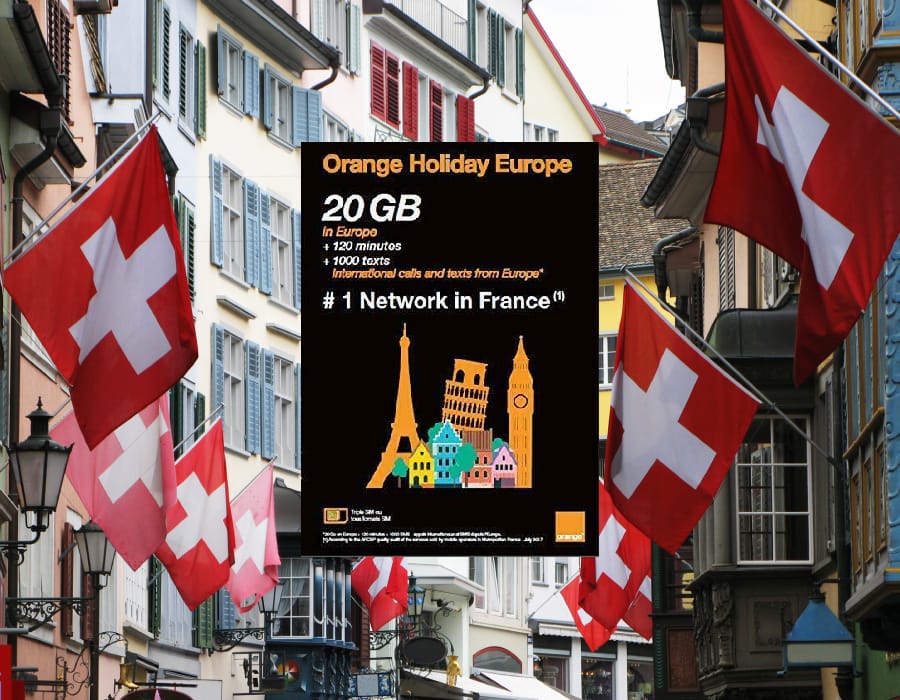
The Orange Holiday Europe Prepaid SIM Card is probably the best all-around SIM card that can be pre-purchased for your trip to Switzerland because it offers 20GB of mobile data at a fair price. This plan gives you a European phone number that can be used to make/receive calls and texts anywhere in Europe.
Additionally, Orange is one of the largest mobile companies in Europe so they’re a legit company that has great coverage throughout most of Europe (which isn’t always the case with smaller European carriers).
The only thing I don’t like about the Orange Holiday Europe SIM Card is its 14-day validity period—which doesn’t matter if your trip is less than two weeks. That said, you can buy an extra 10GB of credit after the two weeks are up for around $25.
Orange Holiday Europe SIM Card Specs:
- PRICE: $50
- DATA: 20GB
- CALLS: Unlimted in Europe and 1200 minutes worldwide
- TEXT: Unlimted in Europe and 1000 worldwide
- USED AS A MOBILE HOTSPOT?: Yes
- CREDIT VALID FOR: 14 Days
- COVERAGE AREA: All of Europe (including Switzerland)
Check out the Orange Holiday Europe eSIM if you’d rather have the eSIM version of the Orange Holiday Europe data plan.
Orange Holiday Zen Prepaid SIM Card
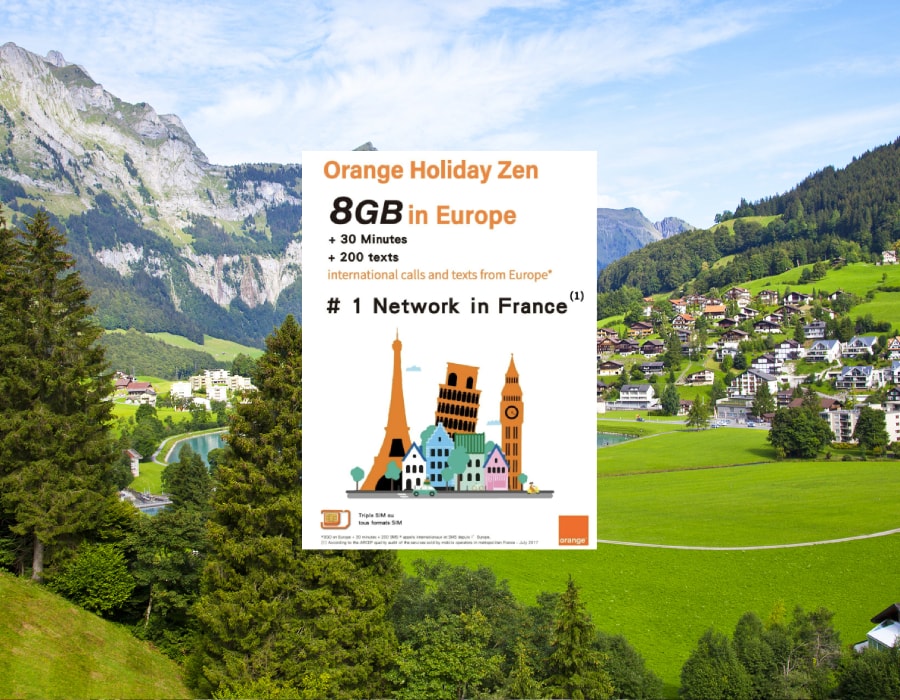
For lighter data users, I recommend the $30 Orange Holiday Zen SIM Card—it gives you 8GB of data for 14 days but otherwise, it’s essentially the same plan as the Orange Holiday Europe SIM.
Orange Holiday Zen SIM Card Specs:
- PRICE: $30
- DATA: 8GB
- CALLS: Unlimted in Europe and 600 minutes worldwide
- TEXT: Unlimted in Europe and 500 worldwide
- USED AS A MOBILE HOTSPOT?: Yes
- CREDIT VALID FOR: 14 Days
- COVERAGE AREA: All of Europe (including Switzerland)
Check out the Orange Holiday Zen eSIM if you’d rather have the eSIM version of the Orange Holiday Zen data plan.
Three UK Prepaid SIM Card
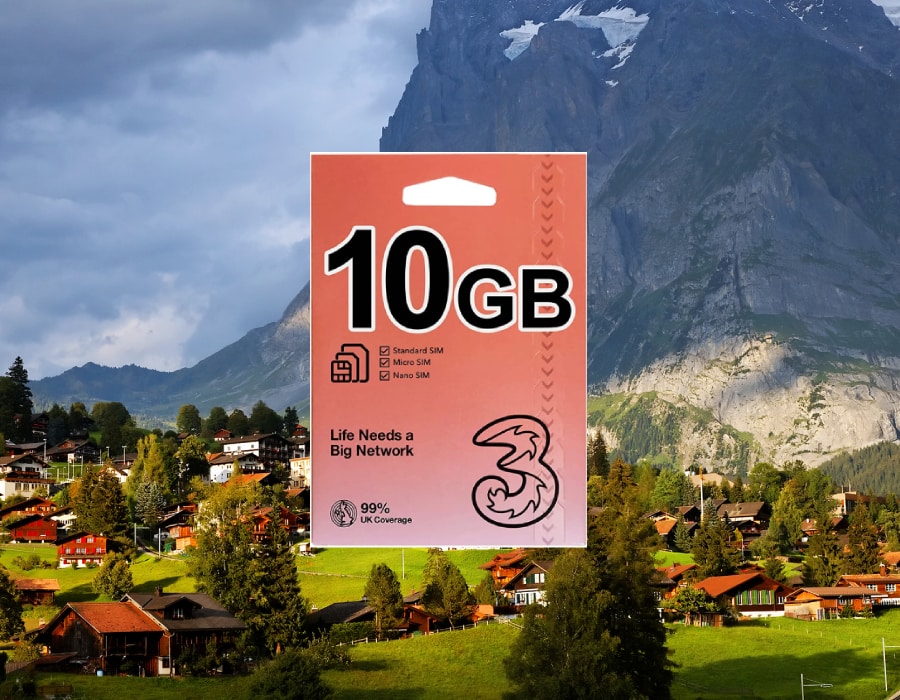
You can also check out the various data plans from Three. They have data plans that range from $25-$80 and come with 10GB to 24GB of data—I’d stick with Three Data Pack 10GB or Three Data Pack 12GB plans because those offer the best value.
The Data Pack 10GB and Data Pack 12GB both come with unlimited calling and texts within Europe and both plans are valid for 30 days so they’re good for longer trips.
Three Data Pack SIM Card Specs:
- PRICE: $25
- DATA: 10GB
- CALLS: Unlimted in Europe
- TEXT: Unlimted in Europe
- USED AS A MOBILE HOTSPOT?: No
- CREDIT VALID FOR: 30 Days
How To Buy A SIM Card In Switzerland

Let’s take a look at how to buy a prepaid SIM card once you’re already in Switzerland. The process is straightforward—the biggest hassle is finding a shop that sells them and then choosing the plan that’s right for your trip. Be sure to bring your passport because shops are required to register your purchase with the Swiss government.
NOTE: Many Swiss mobile companies will charge you an activation fee for the prepaid SIM card and then you have to buy a month of service on top of that. So your upfront cost of the service and SIM activation could be around $75 USD (which makes it expensive if you’re only visiting for a few days).
The Major Swiss Mobile Data Providers
Three companies in Switzerland own their mobile infrastructure— Swisscom, Sunrise, and Salt.
Swisscom is the largest network and they have the best coverage and fastest speeds. Sunrise and Salt have made improvements over the past few years but Swisscom is still number one.
All three companies will have storefronts in every major city so you just need to drop by and they’ll help get you set up.
The downside to using one of these major carriers is the price. For example, a gigabyte of mobile data from Salt is around $17 so it’s easy to spend a lot on data. And you might have to pay an activation fee—for example, Swisscom charges $22 USD for the SIM (but that includes $22 worth of credit).
Another option is to buy data from a budget carrier that leases bandwidth from one of the large carriers. These cheaper plans are typically sold at grocery stores, newsstands, convenience stores, vending machines, train stations, airports, etc. You’ll have to visit a few of these shops to compare the different deals.
Don’t expect as good of service with these budget carriers and you probably won’t get any kind of tech support if you run into any issues.
FAQ: Prepaid Swiss SIM Card Data Plans
Here are a few general things to keep in mind when using mobile data in Switzerland.
Bring Your Passport
All mobile data plans require you to provide your passport information and sometimes they’ll ask for a local address (which can be your hotel or rental apartment address).
Don’t Expect Coverage Outside Switzerland
Most mobile data plans sold in Switzerland don’t work outside Switzerland or you’ll be charged an extremely high international roaming rate.
Your Phone Must Be Unlocked
Some mobile carriers (mainly in the US, Australia, and New Zealand) “lock” their phones so they’ll only work on that carrier’s network—this typically applies if you have a plan that includes a free phone with a multi-year contract. You’ll need to contact your carrier and have them “unlock” your phone so it will accept a third-party SIM card.
In the US, carriers are required to unlock phones if the customer requests it but it’s rarely unlocked by default. That said, a few companies still make customers jump through hoops to unlock their phones so don’t put this off until the last minute or you could be out of luck.
A New SIM Card Gives You A New Phone Number
Installing a new Swiss SIM card gives you a new Swiss phone number so your old number won’t work until you reinstall your original SIM card. So, if people need to reach you, you’ll need to tell people your new Swiss number.
One of the benefits of using an eSIM is that you can keep your phone’s number while also using your new eSIM. Read my Guide To Using eSIM Plans in Europe to learn more.
Furthermore, many websites/apps use two-factor authentication that’s tied to your phone number so that will no longer be an option with the new SIM installed. And if you use Uber/Lyft, you’ll need to update your new phone number in the app when you install your new SIM.
Avoid Your Plan’s International Data Plan
Your current mobile phone provider likely offers an international data plan but it’s typically expensive and the service is often slow, inconsistent, and has limited data allowances.
For example, the AT&T International Day Pass costs $10/day, Verizon TravelPass is also $10/day and many T-Mobile plans offer free international roaming but you’re only guaranteed 2g data speeds… which will struggle to load Google Maps or even email.
How Much Mobile Data Do You Need?
As long as you’re not streaming music/videos or uploading a ton of photos, you probably won’t use more than 4GB-8GB of mobile data a week. For reference, the average American smartphone owner uses around 15-20GB of mobile data each month.
If you’re spending a lot of time on social media (notably Instagram and TikTok) then you might use a bit more but if you’re just doing normal web browsing and using Google Maps then you might only use 1-2GB a week.
Keep Your Old SIM Card Safe
If your current phone uses a SIM card, be sure to keep the SIM in a safe place while using your Swiss SIM because you’ll need to reinstall the old card to use your normal service.
GENERAL TIPS FOR USING YOUR PHONE IN SWITZERLAND
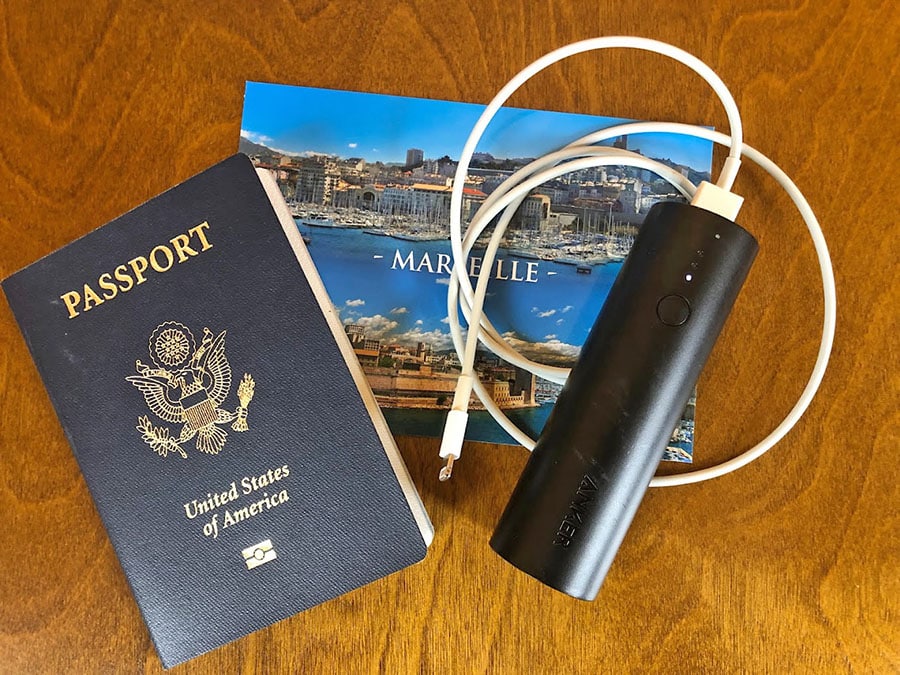
I’ve written extensively about using smartphones and data plans in Europe and tips for buying SIM Cards For Visiting Europe. Below are some more helpful tips about using your phone in Switzerland and throughout Europe.
BRING A PORTABLE BATTERY CHARGER
Traveling with your phone will quickly drain your batteries so I highly recommend a portable battery. I use Anker PowerCore 10000 because it’s tiny and affordable but there are multiple options.
BE AWARE OF THEFT WHILE USING YOUR PHONE
Pickpockets love stealing smartphones so pay attention while you’re using your phone, stash it away safely while on public transportation/crowds, and don’t set it down while you’re in public. Read my guide to Pickpockets in Europe for more anti-theft advice.
TAKE STEPS TO LOWER YOUR MOBILE DATA USAGE
It’s easy to burn through a lot of data because many apps use data in the background. Facebook, email, Instagram, Snapchat… those all constantly use data throughout the day without you knowing it. That’s it’s important to know how to limit your data usage.
- USE AIRPLANE MODE AND BLOCK DATA TO SPECIFIC APPS: I’ll put my phone in Airplane Mode because that disables all data (but GPS still works in Airplane Mode). You can also go into the settings and disable data access to each app. I’ll go in and turn every off except for things like Google Maps or others that I’ll use more frequently — this way when I turn off Airplane Mode only those apps that will use data. Then I’ll turn Airplane Mode back on when I’m done.
- DOWNLOAD OFFLINE MAPS: Google Maps lets you download entire city maps so they can be used offline. As a bonus, GPS doesn’t use data so offline Google Maps works fairly well (but not all functionality works). Here is a good YouTube video that explains everything.
- SAVE HEAVY PHONE USAGE FOR WIFI: Wait until you’re somewhere with a WiFi connection before you do any heavy streaming or download files.
More Europe Travel Tips From The Savvy Backpacker

Here are a few articles I’ve written about traveling through Switzerland and Europe.
- Complete Guide To Train Travel In Europe
- Backpacking Europe Packing List
- Travel Europe Packing List for Women
- Best Travel Backpacks
- Best Travel Shoes
- Using Money In Europe: ATMs, Credit Cards, Debit Cards, Exchange Rates

No Funny Business
The Savvy Backpacker is reader-supported. That means when you buy products/services through links on the site, I may earn an affiliate commission—it doesn’t cost you anything extra and it helps support the site.
Thanks For Reading! — James
Questions? Learn more about our Strict Advertising Policy and How To Support Us.



